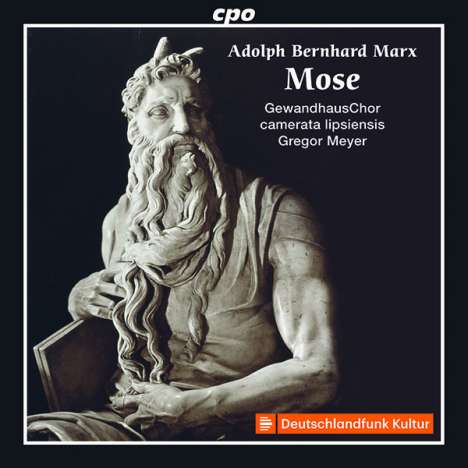Adolph Bernhard Marx: Mose (Oratorium) auf 2 CDs
Mose (Oratorium)
Herkömmliche CD, die mit allen CD-Playern und Computerlaufwerken, aber auch mit den meisten SACD- oder Multiplayern abspielbar ist.
- Künstler:
- Johanna Knauth, Julia Sophie Wagner, Henriette Gödde, Tobias Hunger, Florian Sievers, GewandhausChor Leipzig, Camerata Lipsiensis, Gregor Meyer
- Label:
- CPO
- Aufnahmejahr ca.:
- 2019
- Artikelnummer:
- 9254298
- UPC/EAN:
- 0761203514526
- Erscheinungstermin:
- 12.10.2020
Fortschrittliches Oratorium
Nicht für den Gottesdienst, sondern für den Konzertsaal hat Adolph Bernhard Marx sein groß besetztes dreiteiliges Oratorium „Mose“ für Soli, Chor und Orchester komponiert, auf ein aus den Büchern Mose und weiteren Teilen des Alten Testaments selbst verfasstes Libretto. 1841 wurde „Moses“ in Breslau uraufgeführt. Keine Frage: der streitbare Mose polarisierte und löste eine grundlegende Debatte um die weniger geistliche als musikdramatische Gattung »Oratorium« in der Fachpresse aus. Dabei wollte Adolph Bernhard Marx nur etwas „Neues“ mit seinem „Mose“ schaffen. Mehr als ein traditionelles Oratorium, fortschrittlich gedacht in Anlage, Harmonik und Dramaturgie. Aus heutiger Sicht ein Werk zwischen Mendelssohn und Wagner. Charakteristische Instrumente verleihen den Arien je eine individuelle Farbe – etwa die klagende Oboe, die gemeinsam mit Mirjam im ersten Teil der Not des Volkes Israel Ausdruck gibt, die Posaunen, die häufig den Worten von Mose und Aaron prophetische Würde und Gewicht verleihen, die Klarinette, die sanft das Chor-Gebet zu Beginn des dritten Teils intoniert, die Piccoloflöte, die zur Höllenfahrt aufgellt, oder die Trompeten, die mit gewaltigen Fanfaren Moses Aufforderung »Auf, Volk des Herrn, sei stark in deinem Gott!« unterstreichen.
Product Information
Progressive Oratorio
Adolph Bernhard Marx composed his three-part oratorio Moses for soloists, chorus, and full orchestra not for a religious service but for performance in the concert hall and drew on the Books of Moses and other parts of the Old Testament to write his libretto for it. Moses celebrated its premiere in Breslau in 1841, and no doubt about it: this contentious work had a polarizing effect and sparked a fundamental debate in the music press about the genre of the »oratorio« when it was less a sacred work and more a music drama. However, Marx had merely wanted to create something new with his Moses. Going beyond a traditional oratorio, it was supposed to be progressive in design, harmony, and dramaturgy. From today’s perspective, it is a work between Mendelssohn and Wagner. Characteristic instruments lend each of the arias an individual color. For example, the mournful oboe joins Miriam in expressing the distress of the people of Israel in the first part; the trombones frequently endow the words of Moses and Aaron with prophetic dignity and weight; the clarinet gently intones the choral prayer at the beginning of the third part; the piccolo contributes shrill tones to the descent into hell; and the trumpet employs mighty fanfares to underscore the exhortation uttered by Moses: »Up, people of the Lord, be strong in your God!«
Rezensionen
klassik-heute.de 12/2020: »Dirigent Gregor Meyer hatte das Glück, für seine Aufführung des Mose auf durchweg hervorragend disponierte Gesangssolisten zurückgreifen zu können. Auch der GewandhausChor zeigt sich bestens einstudiert und bewältigt die mitunter vertrackte Polyphonie scheinbar mühelos. Die Aufnahme ist ein kräftiges Plädoyer für das Werk und als solches zu empfehlen!«Disk 1 von 2 (CD)
Mose (Oratorium aus der Heiligen Schrift)
-
1 Chor: Wehe! - Ich erliege (1. Teil: Die Berufung)
-
2 Chor: Es geht Gewalt über Recht!
-
3 Chor: Gieße deine Ungnad' auf sie herab
-
4 Rezitativ: Du böse Art, merke auf des Herrn Wort!
-
5 Chor: All' herbei, all' herbei!
-
6 Arie mit Chor: Hebt' euch von mir
-
7 Solo mit Chor: Herr, du bist es allein!
-
8 Arie: Der Winter ist gegangen
-
9 Finale: Mose!
Disk 2 von 2 (CD)
-
1 Arie: Was betrübst du dich, meine Seele (2. Teil: Das Gericht)
-
2 Chor: Seht, seht da!
-
3 Duett mit Chor: Stärket die müden Hände
-
4 Chor mit Solo: Der König freue sich in seiner großen Macht
-
5 Doppelchor: Wohl her nun, lasst sie uns plagen!
-
6 Chor: Der Strom ward Blut!
-
7 Arie: Du, den meine Seele liebt
-
8 Rezitativ mit Chor: Erwecke dich Herr, warum schläfst du?
-
9 Cavatine: Liebes Kind, gehorche mir
-
10 Quartett: Erwecke dich, Herr
-
11 Chor: Finsternis!
-
12 Finale: Hilft! Wir sind alle des Todes!
-
13 Wechselchöre: Nun merk' ich, dass der Herr dem Gerechten hilft (3. Teil: Der Bund)
-
14 Arie: Gott, der Herr, ist Sonne und Schild!
-
15 Doppelchor: Du, Mose und Aaron
-
16 Doppelchor: Auf, zerreißet ihre Bande!
-
17 Szene mit Chor: Warum bekümmerst du deinen Knecht, o Herr?
-
18 Chor und Solo: Auf, Volk des Herrn!
-
19 Finale: Siehe nun herab
Mehr von Julia Sophie Wa...
-
Albert LortzingZum Groß-Admiral (Oper in 3 Akten)2 CDsVorheriger Preis EUR 29,99, reduziert um 0%Aktueller Preis: EUR 14,99
-
Enjott SchneiderSymphonie Nr.8 "Die Glocke - Brücken zur Unendlichkeit"CDAktueller Preis: EUR 18,99
-
Enjott SchneiderGeistliche Musik Vol.12CDAktueller Preis: EUR 14,99
-
Richard FluryA Florentine TragedyCDAktueller Preis: EUR 15,99














